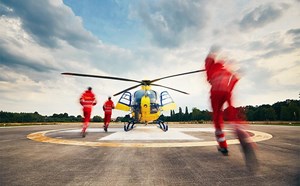
Accessorizing the Long Gun
Brian L. Springer, MD, FACEP
Arming Tactical Medical Professionals (TMPs) is a topic the Tactical EMS Section has discussed before. Controversy aside, once the decision has been made that the TMP will carry a firearm during operations, careful consideration must be given as to the specific weapon platform that will be chosen, and any accessories to enhance the weapon’s safety, effectiveness, and ease of use. It is my belief that the pistol is the ideal weapon for the TMP in most circumstances: it is compact, lightweight, easy to carry, allows use of both hands for medical care when holstered, and can quickly be accessed and brought into action if needed. However, circumstances may dictate that the TMP is better served with a long gun, specifically a military/LE caliber semiautomatic rifle.
The carbine-length AR design, whether piston driven or (far more commonly) direct impingement, has become the police long gun of choice, largely supplanting the duty shotgun. Rifle advantages include greater ammunition capacity, ease of use, enhanced range and hit probability, and decreased risk of overpenetration or stray projectiles. The primary disadvantage of any long gun to a TMP is weight and bulk, particularly when trying to manage casualties.
The TMP should ideally run the same or at least a similar carbine as the operators on their team. As I noted in my previous article on handguns for TMPs, the advantages to carrying the same platform as your team members include:
- Familiarity with the weapon should a situation arise where you need to handle an operator’s weapon, whether to fire it or render it safe
- The above applies if an operator needs to access your weapon
- Having the same caliber and compatible magazines allows for ammunition to be shared in the event of an extended operation
- Similar maintenance procedures and supplies allows the TMP to keep the weapon well maintained and duty-ready
- In the event of a shooting, the fact that you are carrying the same weapon system as your team members eliminates the ability of a plaintiff’s attorney to single out your weapon and try to make it look like you were itching for a fight or wanting to shoot someone
There are many manufacturers making top quality AR-style carbines. Bravo Company Manufacturing, Daniel Defense, Noveske, and Colt are only a few. Better to spend a little more up front and get a weapon that is reliable and will stand up to years of hard use. I would advise against building your own, a popular pastime among shooting enthusiasts. Carrying a DIY firearm could be spun to make you look irresponsible in the event of a shooting. For a weapon to be used in the LE context, my advice is to stick with a 16-inch barrel unless you are issued a firearm with a shorter barrel or commit to registering your firearm with the ATF as a short barreled rifle (SBR).
There are several accessories that are essential if you will be carrying a carbine with you into the field. They are:
- Quality optic
- Back up sights
- Sling
- Tactical light
Optic: For reliability, ease of use, and basic effectiveness, it is hard to beat a non-magnified electronic optic. Basic red-dot optical sights from Aimpoint and Trijicon, or a holographic sight like that made by EOTech, enhance target identification, and hit probability, eliminating the need to shift focal planes when engaging a target. Reliability and battery life have evolved to where an optic can be left activated and ready to go for years without needing battery replacement. Magnification is unlikely to be needed at the distances most commonly encountered in law enforcement encounters, especially when considering defensive use by the TMP.
 Short-barreled rifle (SBR) with Aimpoint T1 Micro optic, back-up sights deployed,
Short-barreled rifle (SBR) with Aimpoint T1 Micro optic, back-up sights deployed,
Surefire Scout Light with pressure switch.
If the need to identify of targets at distance is anticipated, for example if you primarily work in a rural setting, there are several options for magnification. Flip-up magnifiers work with most red dot and holographic sites by placing magnifying optics between your eye and the sight. They are moved out of the way when no magnification is needed. Fixed magnification optics like the Trijicon ACOG are rugged, reliable, and can be had with battery back-ups to illuminate the reticle. At closer range, these optics can be used quite effectively using the Bindon Aiming Concept® where binocular vision projects the reticle over the target identified by the non-dominant eye. Low Power Variable Optics (LPVOs) which let you change between no magnification and low power magnification are an option, though weight, price and battery life can be an issue. As technology improves these sights should become lighter, more rugged, and have improved reticle battery life.
High quality mounting hardware with quick release levers can simplify putting optics on your gun and help to maintain accuracy. After removing and remounting an optic you will need to check the zero – that is make sure the round goes where you have aimed. Correctly zeroing of the law enforcement carbine depends on the distances you anticipate shooting and a variety of other factors about your gun and ammunition.
Back-up sights: True, reliability and battery life of electronic optics has never been better. But Murphy’s law still holds sway over all, and the TMP must have the means to use sighted fire when an optic breaks, has a dead or defective battery, or has inadvertently been shut off. Fixed back-up sights are the fastest alternative when the optic fails. With minimal practice, one can learn to ignore partial or fully co-witnessed fixed sights in the optic field. If desired, fold-down back-ups are available, though they require several seconds to bring into play if needed.
Sling: The ability to sling your carbine is essential, providing the opportunity to use both hands for other tasks. Climbing obstacles, transitioning to handgun, and treating or moving casualties require the long gun to be quickly and reliably slung. A quick-adjustable two-point sling is best, giving the most options for securing the weapon against the body. Slings that can transition between single point and two-point can be tactically advantageous, and some sling designs allow you to adjust your sling quickly for the gear you are wearing. A few key points to remember: set the length of the sling with your full kit in place. Remember that if you wear other strap-mounted gear (such as a medical backpack), having a weapon slung over it may impede your ability to doff the pack, and vice versa if you need to quickly unsling the weapon. Strategic placement of quick release buckles can be helpful. Always place the weapon on safe before securing it against the body, keep the safety facing outboard to lower the risk of unintentional discharge, and be cognizant of where the weapon’s muzzle is pointing.
 SBR with Blue Force Gear Vickers Padded Sling.
SBR with Blue Force Gear Vickers Padded Sling.
Note tan “quick adjuster” tab and quick-detach swivel mounts.
Tactical light: A quality tactical light such as those offered by Surefire, Streamlight, and Inforce will help locate and identify targets, temporally blind targets, illuminate target hands to scan for the presence of a weapon, and enhance the ability to identify other threats or no-shoot targets near the threat. Lights designed for use on carbines will provide the ideal lumens and beam pattern for tactical long gun distances. Pressure activated switches allow for quick-on quick-off, and enable one to run the light while still maintaining a solid forward grip on the gun. If you run a vertical foregrip, the pressure switch can be mounted on the grip, plus there are vertical foregrips available with an integrated light. Be aware that if you are running a pistol which is not registered as an SBR, the ATF forbids the use of a vertical foregrip.
 Inforce WML light. Safety lever is in upward position to prevent inadvertent actuation during storage
Inforce WML light. Safety lever is in upward position to prevent inadvertent actuation during storage
or transport. Note Aimpoint optic and mid-barrel back-up front sight in photo background.
A few other tips and tricks: a good flash hider like the military-style “birdcage” or the Noveske Flaming Pig reduce muzzle flash and noise. A muzzle compensator or muzzle brake may give you slightly faster shot-to-shot splits (great for competition) but will significantly increase your muzzle blast and noise, especially for anyone standing astride of you, even with hearing protection. Suppressors (aka silencers) reduce noise signature and the risk for hearing loss. Visible lasers can enhance close-range targeting, and infrared lasers are useful when working with night vision optic devices or night vision googles. Do not put Punisher skulls, “Molon Labe”, or other provocative markings on your weapon, unless you want them projected in front of a jury while a prosecutor paints you as a blood-thirsty killer.
Above all, practice, practice, practice. Train regularly with your long gun. Safe handling should become second nature. Train in full kit; it is very different running a gun “slick” versus with full gear, helmet, and medical bags. Remember, your role is to enhance the safety of your team and provide care in the direst of circumstances. Know your gear, keep your role straight, and train with purpose.
All photographs by Brian L. Springer



